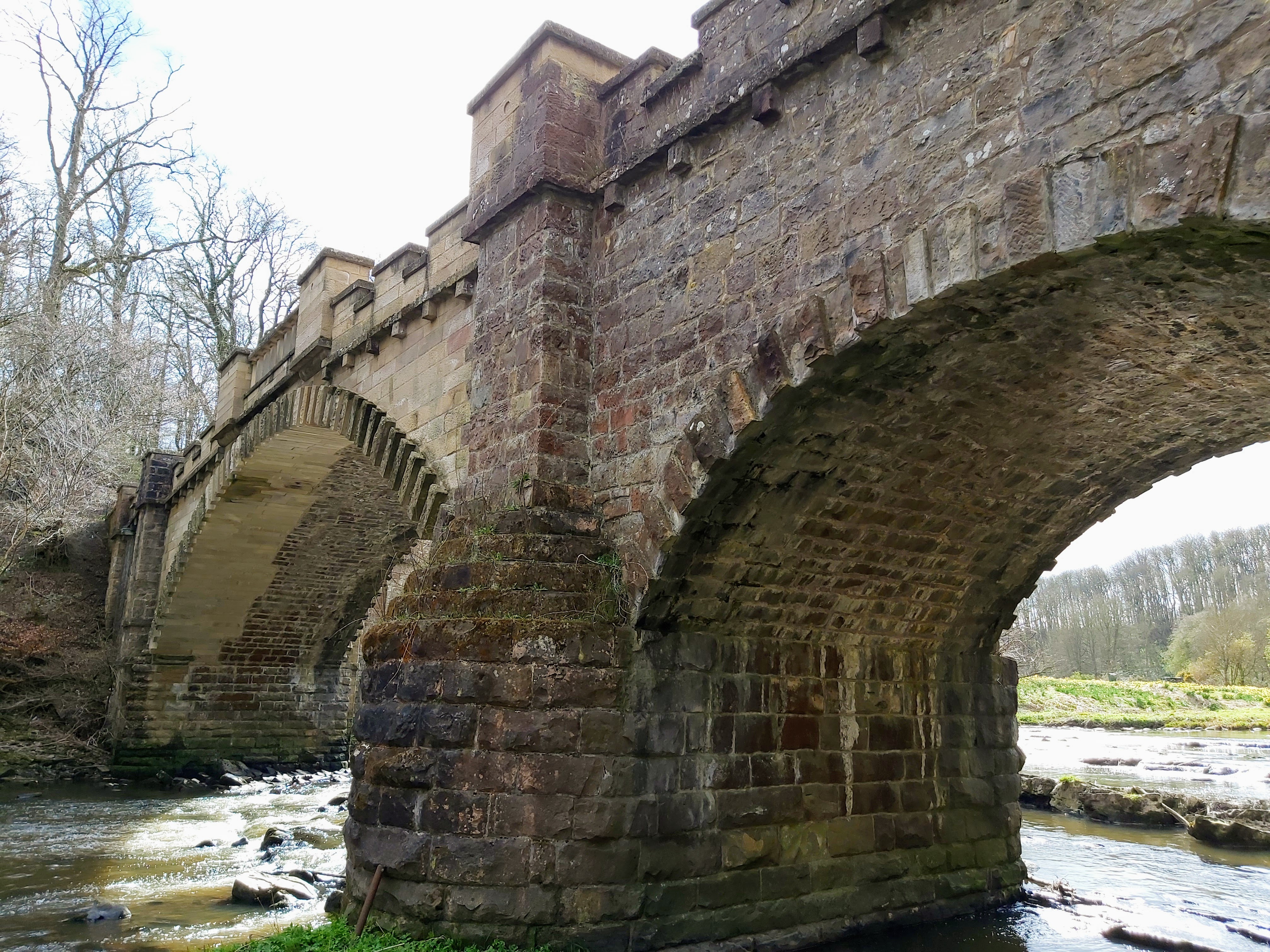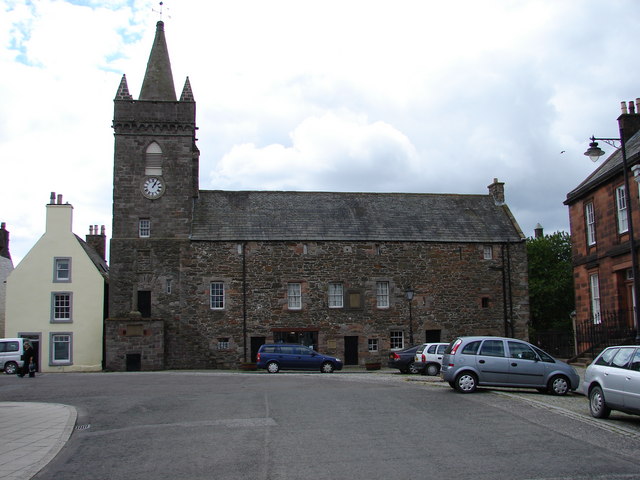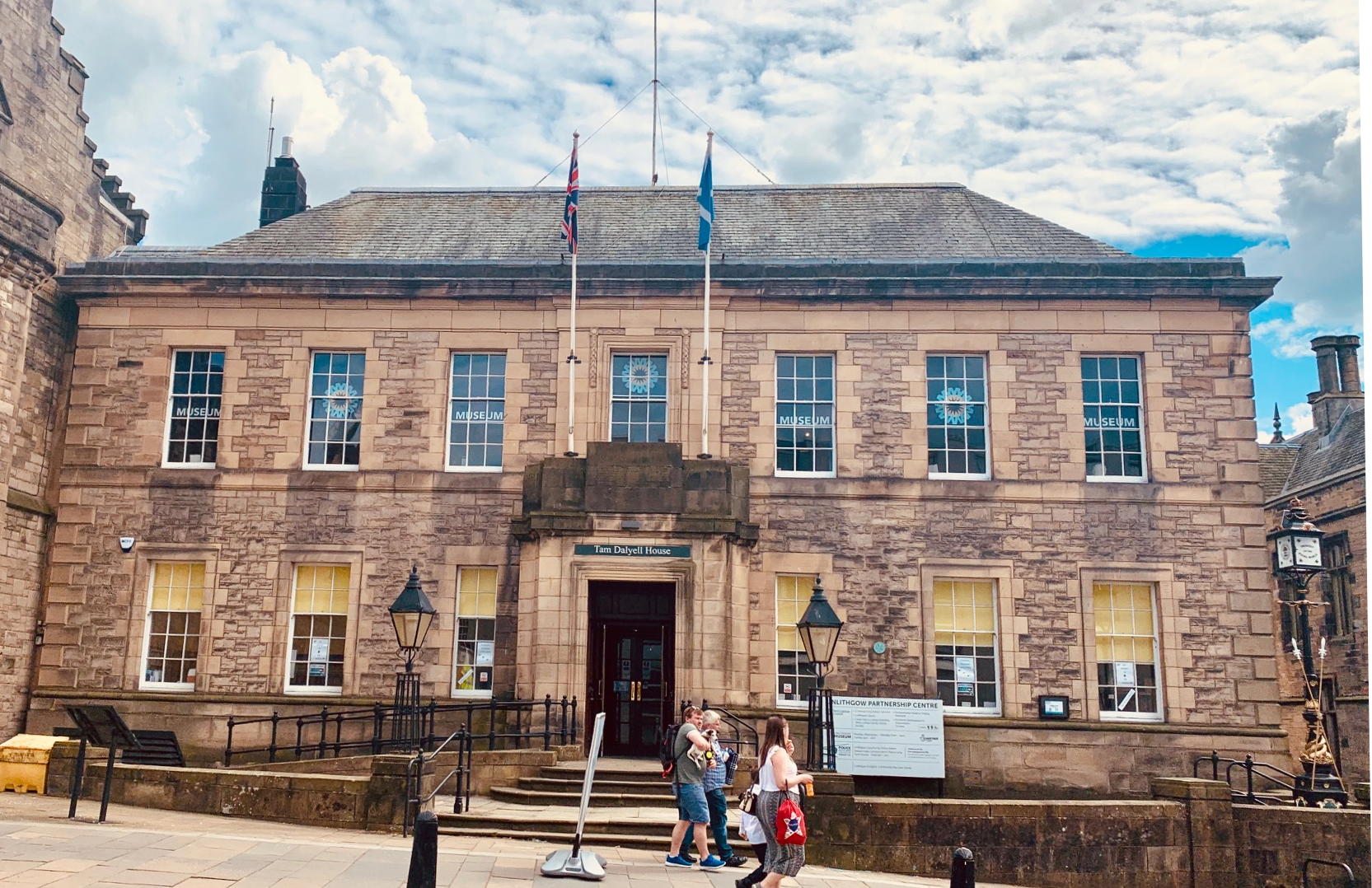|
Nasmyth Bridge
The Nasmyth Bridge (also known as the Almondell Bridge) is a Category A Listed historic bridge and local landmark in East Calder, Scotland. Located within the Almondell and Calderwood Country Park, it was designed by Scottish painter, architect, and landscape designer Alexander Nasmyth. History The bridge was commissioned by Scottish Whig lawyer Henry Erskine to provide a southern approach to his country residence Almondell House, spanning over the River Almond, from the old Edinburgh-Glasgow route as this enters East Calder. Alexander Nasmyth was commissioned to design the bridge sometime between 1806 and 1810, most likely following the success of a bridge he had designed in 1808 for the Earl of Selkirk on the River Dee, at Tongueland near Kirkcudbright. The Almondell Bridge was completed by 1811, as attested by an oil on canvas painting of the Almondell Bridge by Nasmyth himself, dated from that year, which is its earliest known representation. Erskine's mansion was buil ... [...More Info...] [...Related Items...] OR: [Wikipedia] [Google] [Baidu] |
East Calder
East Calder is a village located in West Lothian, Scotland, about a mile east of Mid Calder and a mile west of Wilkieston. It forms part of 'the Calders (together with Mid and West Calder), three small neighbouring communities situated west of Edinburgh and south of the "New Town" of Livingston. Its fast growth rate in the early 21st-century is driven by its being within easy commuting distance of Livingston, Edinburgh and Glasgow, combined with its close position relative to the principal transport arteries of the M8 motorway, the A89 and A71 roads, the Edinburgh – Glasgow railway line (the Shotts Line), and Edinburgh Airport. The East Calder Gala is a local highlight held every June, dating back to 1919. Geography East Calder lies in the lee of the Pentland Hills within the Almond River Valley, near the right bank of the river, and specifically in the East Calder / Livingston / Broxburn Plain, a ''Lowland Plains'' type landscape. Given its location on top of a natural ... [...More Info...] [...Related Items...] OR: [Wikipedia] [Google] [Baidu] |
West Lothian
West Lothian ( sco, Wast Lowden; gd, Lodainn an Iar) is one of the 32 council areas of Scotland, and was one of its shires of Scotland, historic counties. The county was called Linlithgowshire until 1925. The historic county was bounded geographically by the River Avon, Falkirk, Avon to the west and the River Almond, Lothian, Almond to the east. The modern council area occupies a larger area than the historic county. It was reshaped following local government reforms in 1975: some areas in the west were transferred to Falkirk (council area), Falkirk; some areas in the east were transferred to Edinburgh; and some areas that had formerly been part of in Midlothian were added to West Lothian. West Lothian lies on the southern shore of the Firth of Forth and is predominantly rural, though there were extensive coal, iron, and shale oil mining operations in the 19th and 20th centuries. These created distinctive red-spoil heaps (locally known as "bing (mining), bings") throughout the ... [...More Info...] [...Related Items...] OR: [Wikipedia] [Google] [Baidu] |
Scotland
Scotland (, ) is a country that is part of the United Kingdom. Covering the northern third of the island of Great Britain, mainland Scotland has a border with England to the southeast and is otherwise surrounded by the Atlantic Ocean to the north and west, the North Sea to the northeast and east, and the Irish Sea to the south. It also contains more than 790 islands, principally in the archipelagos of the Hebrides and the Northern Isles. Most of the population, including the capital Edinburgh, is concentrated in the Central Belt—the plain between the Scottish Highlands and the Southern Uplands—in the Scottish Lowlands. Scotland is divided into 32 administrative subdivisions or local authorities, known as council areas. Glasgow City is the largest council area in terms of population, with Highland being the largest in terms of area. Limited self-governing power, covering matters such as education, social services and roads and transportation, is devolved from the Scott ... [...More Info...] [...Related Items...] OR: [Wikipedia] [Google] [Baidu] |
River Almond, Lothian
The River Almond ( gd, Abhainn Amain) is a river in Lothian, Scotland. It is approximately 28 miles (45 km) long, rising at Hirst Hill in Lanarkshire near Shotts, running through West Lothian and draining into the Firth of Forth at Cramond, Edinburgh. The name Almond/Amon is simply old Celtic for "river". Environment Running through areas that were dominated for much of the 20th century by heavy industry and shale- and coal mining, the River Almond has long been notorious for its high levels of pollution. With the demise of mining and heavy industry in Central Scotland, the river became cleaner, and it is being actively repopulated by wildlife: there is a healthy population of brown trout and there are improving runs of both Atlantic salmon (''Salmo salar'') and sea trout (''Salmo trutta''). There is also a good array of birds to be seen around the river banks, including dippers, kingfishers and grey herons, and increasing numbers of otters are being reported. The river is ... [...More Info...] [...Related Items...] OR: [Wikipedia] [Google] [Baidu] |
Nasmyth Bridge NE View
This page includes variants Nasmith, Nasmyth, and Naysmith. General * Naismith's Rule, used in hiking * Nasmyth telescope * Primary enamel cuticle, also known as ''Nasmyth's membrane'' Places * Naismith, Montana * Nasmyth (crater) on the Moon Companies * McClure Naismith, Scottish commercial solicitors * Nasmyth, Gaskell and Company (1836–1850), production of heavy machine tools and locomotives, later James Nasmyth and Company (1850–1857), Patricroft Ironworks (1857–1867), Nasmyth, Wilson and Company (1867–1940) People Naismith (Nasmith, Nasmyth, Naysmith) is an occupational surname for a cutler, and may refer to: Naismith * Alby Naismith (born 1917), Australian rules footballer * Charlie Naismith (1881–unknown), Australian rules footballer * James Naismith (1861–1939), Canadian sports coach and innovator, inventor of basketball * James Naismith (chemist) (born 1968), chemical biologist * Jason Naismith (born 1994), Scottish footballer * Jon Naismith (b ... [...More Info...] [...Related Items...] OR: [Wikipedia] [Google] [Baidu] |
Almondell And Calderwood Country Park
Almondell and Calderwood Country Park is a Country Park in Mid Calder and East Calder in West Lothian, Scotland. It is a 4 star Visitor Attraction (Visitscotland). The Park is split into two main areas, Almondell Park which comprises the Almondell estate which originally belonged to the Erskine family of Broxburn and the Calderwood estate which once belonged to the Barons of Torphichen. History Almondell House and its estate dates to the 18th century. The House was erected in 1786, designed by its owner Henry Erksine, a lawyer. The house was the historic home of the Earls of Buchan (it is now Newnham House in England). Almondell House was demolished in 1969. The coach house and stable buildings of the house were converted into a visitor centre when the country park opened in the 1970s. The Park also contains the Nasmyth Bridge, spanning over the Almond from the East Calder entrance. The bridge was originally constructed in 1810 to a design by Alexander Nasmyth. It was late ... [...More Info...] [...Related Items...] OR: [Wikipedia] [Google] [Baidu] |
Alexander Nasmyth
Alexander is a male given name. The most prominent bearer of the name is Alexander the Great, the king of the Ancient Greek kingdom of Macedonia (ancient kingdom), Macedonia who created one of the largest empires in ancient history. Variants listed here are Aleksandar, Aleksander and Aleksandr. Related names and diminutives include Iskandar, Alec, Alek, Alex, Alexandre (given name), Alexandre, Aleks (given name), Aleks, Aleksa (given name), Aleksa and Sander (name), Sander; feminine forms include Alexandra, Alexandria (given name), Alexandria, and Sasha (name), Sasha. Etymology The name ''Alexander'' originates from the (; 'defending men' or 'protector of men'). It is a compound of the verb (; 'to ward off, avert, defend') and the noun (, genetive, genitive: , ; meaning 'man'). It is an example of the widespread motif of Greek names expressing "battle-prowess", in this case the ability to withstand or push back an enemy shield wall, battle line. The earliest Attested langua ... [...More Info...] [...Related Items...] OR: [Wikipedia] [Google] [Baidu] |
Henry Erskine (lawyer)
The Honourable Henry "Harry" Erskine (1 November 1746 – 8 October 1817) was a British Whig politician and lawyer. Background and education Erskine was the third but second surviving son of Agnes, daughter of Sir James Steuart, 7th Baronet and his wife Anne (1687-1736), and Henry Erskine, 10th Earl of Buchan. He was the brother of David Erskine, 11th Earl of Buchan, and Lord Chancellor Thomas Erskine, 1st Baron Erskine. His elder sister was Lady Anne Agnes Erskine who was involved with the evangelical methodists of Countess of Huntingdon's Connexion. He was educated at the University of St Andrews (1760-1764), the University of Glasgow (1764-1766) and then to the University of Edinburgh in 1766. He was described as "a tall and rather slender figure, a face sparkling with vivacity, a clear sweet voice, and general suffusion of elegance".Monuments and Statues of Edinburgh, Michael T. R. B. Turnbull, (Chambers) p. 54 Legal and political career Erskine is considered the lawyer wh ... [...More Info...] [...Related Items...] OR: [Wikipedia] [Google] [Baidu] |
River Dee, Galloway
The River Dee ( gd, Dè / Uisge Dhè), in south-west Scotland, flows from its source in Loch Dee amongst the Galloway Hills, firstly to Clatteringshaws Loch, then into Loch Ken, where it joins the Water of Ken. From there, the Dee flows southwards to Kirkcudbright, and into Kirkcudbright Bay to reach the Solway Firth. The distance is just over in total. Together with its tributaries, the Dee's total catchment area is over . The river is dammed at Tongland, two miles (3 km) upriver from Kirkcudbright. This was constructed as part of the Galloway hydro-electric power scheme in the 1930s. Also at this site is Tongland Bridge, built in 1806 by Thomas Telford. The ruins of Threave Castle stand on an island on the lower part of the Dee. In Ptolemy's 2nd century work ''Geography'' it is recorded as ''Dēoúa''. This form represents a development of Proto-Indo-European'' *deiueh2-'' 'a goddess', which occurs in many Celtic river-names. The Dee has also been known as the ... [...More Info...] [...Related Items...] OR: [Wikipedia] [Google] [Baidu] |
Kirkcudbright
Kirkcudbright ( ; sco, Kirkcoubrie; gd, Cille Chùithbeirt) is a town, parish and a Royal Burgh from 1455 in Kirkcudbrightshire, of which it is traditionally the county town, within Dumfries and Galloway, Scotland. The town lies southwest of Castle Douglas and Dalbeattie at the mouth of the River Dee, around from the Irish Sea. History An early rendition of the name of the town was Kilcudbrit; this derives from the Gaelic ''Cille Chuithbeirt'' meaning "chapel of Cuthbert", the saint whose mortal remains were kept at the town between their exhumation at Lindisfarne and reinterment at Chester-le-Street. John Spottiswoode, in his account of religious houses in Scotland, mentions that the Franciscans, or Grey Friars, had been established at Kirkcudbright from the 12th century. John Balliol was in possession of the ancient castle at Castledykes in the late 13th century and Edward I of England is said to have stayed here in 1300 during his war against Scotland. In 1455 Kirkcudb ... [...More Info...] [...Related Items...] OR: [Wikipedia] [Google] [Baidu] |
West Lothian Council
West Lothian Council is the local authority for the council area of West Lothian in Scotland. History West Lothian District Council was created in 1975 as one of four districts within the Lothian region. The West Lothian district took its name from the historic county of West Lothian, which had covered a similar but not identical area. The Lothian region was abolished in 1996, when the four districts in the region, including West Lothian, became unitary council areas. Political control The first election to the West Lothian District Council was held in 1974, initially operating as a shadow authority alongside the outgoing authorities until the new system came into force on 16 May 1975. A shadow authority was again elected in 1995 ahead of the reforms which came into force on 1 April 1996. Political control of the council since 1975 has been as follows: West Lothian District Council West Lothian Council Leadership The leaders of the council since 1996 have been: Elections ... [...More Info...] [...Related Items...] OR: [Wikipedia] [Google] [Baidu] |
Heritage Lottery Fund
The National Lottery Heritage Fund, formerly the Heritage Lottery Fund (HLF), distributes a share of National Lottery funding, supporting a wide range of heritage projects across the United Kingdom. History The fund's predecessor bodies were the National Land Fund, established in 1946, and the National Heritage Memorial Fund, established in 1980. The current body was established as the "Heritage Lottery Fund" in 1994. It was re-branded as the National Lottery Heritage Fund in January 2019. Activities The fund's income comes from the National Lottery which is managed by Camelot Group. Its objectives are "to conserve the UK's diverse heritage, to encourage people to be involved in heritage and to widen access and learning". As of 2019, it had awarded £7.9 billion to 43,000 projects. In 2006, the National Lottery Heritage Fund launched the Parks for People program with the aim to revitalize historic parks and cemeteries. From 2006 to 2021, the Fund had granted £254million ... [...More Info...] [...Related Items...] OR: [Wikipedia] [Google] [Baidu] |






